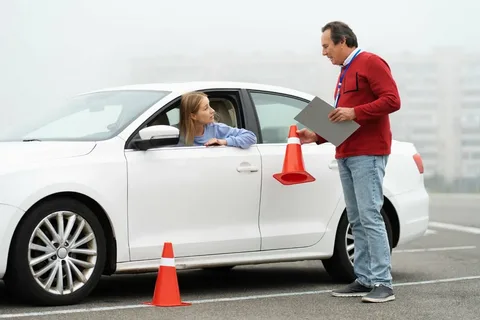I still remember the nervous buzz in my stomach the night before my driving test preparation. My palms were sweaty just thinking about parallel parking. But I also remember that after preparing the right way, things got much easier, and I passed on my first try. If you're preparing for your driving test, this guide is going to help you do exactly that.
At ADC Driving Classes, we’ve worked with hundreds of new drivers and seen exactly what works—and what doesn’t. This post will walk you through everything you need to know: from mental preparation to mastering the wheel, step by step. Let’s dive in.
Why Driving Test Preparation Matters More Than You Think
You’re not just preparing to pass an exam—you’re preparing for real-life driving. A good driver can save lives, avoid accidents, and build lifelong confidence behind the wheel. But guess what? Most people only focus on memorizing signs or repeating parking drills.
That’s not enough.
You need a full-scope approach—one that combines driving skills, situational awareness, test-day mindset, and emotional control. That’s exactly what you’ll get in this guide.
Step 1: Know Exactly What You’re Being Tested On
Before you even touch the steering wheel, get clarity on what your driving test includes. Most driving tests cover the following:
-
Basic maneuvers: Turns, stops, lane changes
-
Parking skills: Parallel parking, reverse parking, three-point turn
-
Road rules: Right-of-way, traffic signals, pedestrian zones
-
Observation: Mirror checks, blind spot awareness, head checks
-
Confidence and control: Smooth handling of the vehicle
Print out the full checklist (usually available on the official driving authority website), and pin it somewhere you see daily. This keeps your goals visible and manageable.
Step 2: Practice Like You’re Taking the Real Test
Many learners make the mistake of only practicing easy routes or driving in familiar areas. The test doesn’t care how good you are in your neighborhood.
To really prepare, simulate test conditions. Here’s how:
-
Ask your instructor or a trusted adult to act like a real examiner.
-
Drive at different times of day (including peak traffic).
-
Practice in all weather conditions—sunny, rainy, and even slightly foggy.
-
Go through a full practice test session without any help.
The more realistic your practice, the calmer you’ll feel on the actual test day.
Step 3: Master the Parking Game
Let’s be honest—parallel parking gives most people nightmares.
The secret? Break it into micro-steps. Don’t aim for perfection. Aim for consistency.
Here’s a simple trick:
-
Align your car parallel to the one ahead.
-
Reverse slowly while turning the steering wheel toward the curb.
-
Midway, adjust the wheel back as your car straightens.
-
Make minor corrections without panicking.
Repeat this 10 times a day for a week. That’s how real mastery builds.
Step 4: Control Your Nerves Before and During the Test
Even the best-prepared students mess up because of one thing: nerves.
You can know every traffic rule and still blank out on test day if your nerves hijack your thinking. So, let’s fix that:
-
Sleep well the night before. Don’t cram. Just relax.
-
Visualize success: Close your eyes and imagine yourself calmly driving, handling turns, parking, and finishing the test confidently.
-
Breathe properly: On test day, use deep breathing techniques. Breathe in through your nose, hold for 3 seconds, and exhale slowly. Do this 4–5 times before starting.
Confidence is not just mindset. It’s a skill. And like any skill, you can practice it.
Step 5: Listen Carefully to the Examiner
During your test, the examiner gives short instructions. Most of them will be straightforward, but you still need to listen closely.
If you miss a step or get confused, ask them to repeat the instruction. It’s better to clarify than to assume and make a wrong move. Examiners appreciate clarity and communication.
Also, don’t rush to show off your skills. Slow, smooth, and cautious driving is often more appreciated than being overly aggressive or fast.
Step 6: Keep Your Eyes Moving (The Golden Rule)
One thing that makes you stand out as a “safe driver” is your eye movement. Examiners notice whether you:
-
Check side mirrors regularly
-
Scan intersections for hazards
-
Turn your head for blind spots
-
Observe pedestrians and cyclists
Your driving should look like this: drive-check-check-move-check again. Let it become second nature. It’s not just about passing the test—it’s about avoiding accidents in real life.
Step 7: Prepare Your Car and Documents
Yes, this seems obvious, but many people forget the basics.
Before the test day:
-
Check if your test vehicle has fuel.
-
Ensure mirrors, brakes, and indicators work.
-
Bring your learner’s permit and any required ID or documents.
Don’t let a flat tire or missing paper cancel your test. Preparation isn’t just mental—it’s practical too.
Step 8: Accept That Mistakes May Happen—and Move On
Nobody drives perfectly, especially not during a test. You might make a small mistake. That’s okay.
Examiners don’t fail you for one missed mirror check. They look for overall safety and control. So if you stall, breathe in, restart, and keep going.
What matters is how you recover—not just what you do right.
Pro Tips from ADC Driving Classes
Here are some underrated secrets we teach our students:
-
Be proactive: Don’t wait for surprises. Anticipate turns and stops in advance.
-
Stay in your lane: Literally and mentally. Don’t compare yourself to other learners.
-
Smile at the examiner: You’re human. They’re human. Lighten the mood.
-
Use both hands on the wheel—always. It's a simple way to show control.
What Happens After the Test?
Once your test ends, don’t overthink. Whether you pass or not, take the feedback as a learning experience. If you passed—congrats! You earned it. If not, no shame at all. Use the notes, practice more, and go again. Many great drivers didn’t pass on their first attempt.
Final Thoughts: This Isn’t Just About a License
Learning to drive is a big deal. It’s about gaining freedom, trust, and a sense of control over your life. If you prepare with purpose, confidence follows naturally.
At ADC Driving Classes, we don’t just teach driving—we help you grow into a confident, aware, and responsible driver for life. Our goal is to make sure every student feels ready not just for the test, but for the real road ahead.



